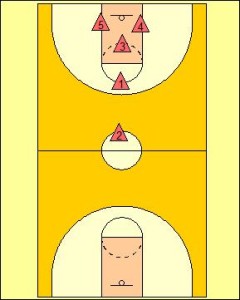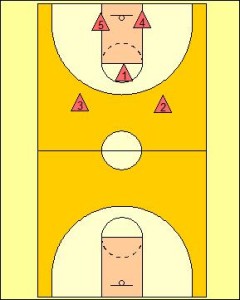Understanding Defensive Transition
Defensive Transition can be one of the more mysterious facets of defence. Many coaches really only learn about defensive transition through watching, and then replicating what another coach does. While this is a great strategy for finding solutions, it however is not the always the best scenario under which to foster a deeper understanding about the transition phase of play. Defensive transition though does not have to be a weakness within a coach’s knowledge or playbook. When a simple step-by-step analysis is applied the fundamentals of this defensive phase can be revealed.
Purpose
The first place to start when thinking about defensive transition is to examine the purpose of this phase. The purpose of an effective defensive transition is to place the team’s players across two distinctive roles. The first of these is offensive rebounding. Players have a specific role of attacking the boards and attempting to secure a second round of possession if the shot misses. The most favourable defensive transition formation has three rebounders forming what is called a “rebounding triangle” consisting of three players in a triangle formation around the basket, but this is only one of many possibilities.

The second grouping of players are the floor defenders. These players fill the role of defending the ball if it is secured by the opposition. Their main purpose is often to stop an early offensive advantage being gained by the opposition. The tactics of how this task is achieved however is something which is often overlooked by coaches with a limited scope.
Objectives
Depending on what defensive transition strategy is employed, the objectives which are intended from the strategy will change. For example, the most utilised defensive transition features a rebounding triangle with two players filling the roles of floor defenders. This defensive transition focuses mainly on containment. Containment is but one option and there are a number of variations within this tactic.
There are a number of different tactics that can be employed. For example, a team may be facing a team that is particularly proficient in fast breaking out of their backcourt. In these situations, a team may wish to only have two players contesting the rebound, while moving an additional player into a supplementary role of a floor defender to help provide extra protection to their own basket.
Another possible option is for a coach to again only choose to have two offensive rebounders, but instead of containing the advancement of the basketball, they may wish to trap and go on the offensive while in defensive transition. This Attacking mindset while in defensive transition is often overlooked and underutilised. However, is a very viable endeavour as many offenses are not able to adapt and cater to the challenges presented by such a tactic.

Different Systems Work for Different Teams
It is a fair to state that not all defensive transition tactics work for every team. There are some teams that will have the tools to warrant three offensive rebounders. It can also be equally argued that for a team with poor offensive efficiency that having additional players rebounding will help fill the gap in a poor shot conversation percentage.
A coach must be very proactive in deciding what option is best to meet the needs of their team. This strategy at first will need to be drilled constantly, but this tactic will over time need to be imbedded in every facet of play. It can be useful for a coach to have a number of different options available in defensive transition. This then allows a coach to make changes in game to meet the needs of their opposition or in being proactive to set the tone of the game.






